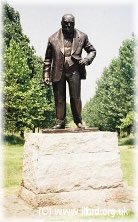|
History
of Ilford
|
Saxon
age to the present day |
|
You wouldn't believe it but elephants, rhinos, tigers and wolves
once inhabited Ilford. In fact, one of the best specimens of a mammoth
with its huge tusks were found in Ilford (go see the skull at the
National History Museum). But that was rather a long time ago. Around
Saxon times existed the hamlet of Ilefort. This name is in the Doomsday
Book. It may have been known as Hile-ford as it was a ford in the
River Hile, which is now the River Roding.
In 1650 Ilford consisted of 60 houses, close together. Since the
arrival of the Great Eastern Railway to the area in 1839, the population
numbers started climbing. In 1880 the population was 10,000 people.
 |
| Winston Churchill
statue in Woodford Green |
In 1910 this climbed to an incredible 78,000. In 1938 it was 167,000.
Peter Griggs was
a well-respected man who was instrumental in building houses to hold
the soaring population. When Ilford grew big enough to have its own
constituency, he was elected as Ilford's first MP in 1918. Griggs
presented a Clock Tower, which was once a major landmark in the area,
to Ilford in 1901 at the Broadway. In 1934 it was relocated to South
Park. It was there destroyed by a V2 bomb during the Second World
War. On October 21, 1926, the present Queen Mother visited Ilford
Town Hall with King George VI, to present the Royal Charter, creating
a Municipal Borough in the County of Essex from the former Urban District
of Ilford. In 1965 it was incorporated into the London Borough of
Redbridge as London grew.
That was not the only Royal visit. There have been others, the
other most notable one being when the present Queen Elizabeth II
visited the 1000th council house completed since 1945 (end of WWII).
 |
| The new Cinema
complex being built, behind the Town Hall |
Large firms that started here include Kelvin Hughes, Howards Ltd,
Plessey Radio and Television Company and Ilford Photographic Company.
Ilford Photographic company is now Ilford Imaging and is a large multinational
company and is perhaps best known for their black and white photo
film on sale at Boots, etc. It started in 1879, when a Mr Alfred Hugh
Harman set up a business in the basement of his house on the corner
of Cranbrook Road and Park Avenue (where the Cranbrook pub is now).
A year after, his business expanded and moved to Roden Street, trading
as the Britannia Works Company, later becoming Ilford Ltd. Britannia
Music is now on/near the old site.
Dr Barnardo's Village Homes for Girls started in Ilford. In 1870
he was offered some land on a rent-free lease for 15 years as a
wedding present. This is where he set up the home and took on six
girls. It soon increased to 60. He decided that so many girls in
one building was not good for them, so he purchased adjoining land
and created separate dwellings. The Queen Mother visited Dr Barnardo's
on June 29, 1935.
John Logie Baird, who invented the television, moved to Ilford
in the mid/late 1920s to work on his new invention. He worked in
a workshop on the roof of Plessey's.
Dowling,
I. And Harris, N. Ilford: The Old Photograph Series (1994). ISBN:
0752400509
Tasker, G. Ilford Past And Present. Redbridge Libraries (1901).
ISBN: 0901616052
Gunby, N. A Potted History of Ilford. (1997). ISBN: 0951583220
Detailed
history on the company Ilford Imaging
|

